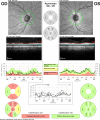Clinical Utility of Optical Coherence Tomography in Glaucoma
- PMID: 27537415
- PMCID: PMC4991023
- DOI: 10.1167/iovs.16-19933
Clinical Utility of Optical Coherence Tomography in Glaucoma
Abstract
Optical coherence tomography (OCT) has established itself as the dominant imaging modality in the management of glaucoma and retinal diseases, providing high-resolution visualization of ocular microstructures and objective quantification of tissue thickness and change. This article reviews the history of OCT imaging with a specific focus on glaucoma. We examine the clinical utility of OCT with respect to diagnosis and progression monitoring, with additional emphasis on advances in OCT technology that continue to facilitate glaucoma research and inform clinical management strategies.
Figures




References
-
- Garcia-Valenzuela E,, Shareef S,, Walsh J,, Sharma SC. Programmed cell death of retinal ganglion cells during experimental glaucoma. Exp Eye Res. 1995. ; 61: 33–44. - PubMed
-
- Quigley HA,, Dunkelberger GR,, Green WR. Retinal ganglion cell atrophy correlated with automated perimetry in human eyes with glaucoma. Am J Ophthalmol. 1989. ; 107: 453 –4 - PubMed
-
- Quigley HA,, Nickells RW,, Kerrigan LA,, Pease ME,, Thibault DJ,, Zack DJ. Retinal ganglion cell death in experimental glaucoma and after axotomy occurs by apoptosis. Invest Ophthalmol Vis Sci. 1995. ; 36: 774 –7 - PubMed
-
- Sommer A,, Miller NR,, Pollack I,, Maumenee AE,, George T. The nerve fiber layer in the diagnosis of glaucoma. Arch Ophthalmol. 1977. ; 95: 2149 –21 - PubMed
Publication types
MeSH terms
Grants and funding
LinkOut - more resources
Full Text Sources
Other Literature Sources
Medical

